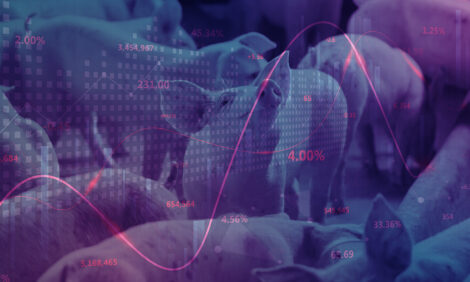



Effects of increasing dietary Lysine in Phase II diets (15 to 25lb) on Nursery pig growth performance
By M.D. Tokach, S.S. Dritz1, J.M. DeRouchey, R.D. Goodband, J.L. Nelssen, and J.L. Usry, and published in Kansas State University's Swine Day 2003. In this article, a total of 1,260 weanling pigs (initially 18.6 lb) was used in a 19 d growth assay (d 10 to 29 after weaning) to determine the effects of increasing lysine in Phase II diets on nursery pig growth performance.Summary
All pigs were
weaned and fed 1.2 lb per pig of a SEW diet,
then switched to a transition diet until day 10
after weaning. Pigs were then weighed and
switched to experimental diets containing true
digestible lysine levels of 1.22, 1.32, 1.42,
1.52, and 1.62%, corresponding to approximately
1.36, 1.47, 1.56, 1.65, and 1.75% total
lysine.
All diets were formulated to contain
30% soybean meal, with increasing amounts
of synthetic amino acids to achieve desired
amino acid concentrations in the diets. From
d 10 to 17 after weaning, increasing lysine increased
ADG (quadratic, P<0.04) and improved
feed efficiency (quadratic, P<0.01),
with both appearing to be maximized at 1.52%
true ileal digestible lysine. From d 17 to 24
and 24 to 29, ADFI and F/G improved (linear,
P<0.05) with increasing true ileal digestible
lysine. For the overall study, (d 10 to 29 after
weaning), increasing true ileal digestible lysine
increased ADG (quadratic, P<0.07) and
improved feed efficiency (quadratic,
P<0.001).
In conclusion, 1.52% true ileal digestible
lysine maximized both ADG and F/G
early in the study, but the lysine requirement
appeared to decrease to 1.42% from d 17 to
24. Results of two recent studies conducted at
the University of Missouri with similar lysine
levels fed to 15- to 25-lb pigs suggest a requirement
estimate between 1.32 and 1.42%
true ileal digestible lysine, slightly lower than
the requirements observed in the present
study.
Introduction
In a previous lysine titration study for 25-
to 45-lb pigs, we found that dietary lysine requirements
appear to be much higher than
previously estimated. In fact, the requirements
for 25- to 45-lb pigs are greater than levels
currently fed to pigs from 15 to 25 lb. In addition
to better growth performance, feeding additional
dietary lysine resulted in improved
margin over feed costs and lowered feed cost
per lb of gain. As pigs grow, their feed intake
increases, and the lysine requirement expressed
as a percentage of the diet decreases.
Therefore, from these previous studies, we
suspect that lysine levels currently fed to 15-
to 25-lb pigs may be too low. Therefore, our
objective was to determine the optimum lysine
level for pigs fed from 15 to 25 lb.
Procedures
A total of 1,260 weanling pigs (initially
18.6 lb) was used in a 19 d growth assay (d 10
to 29 after weaning) to determine the effects
of increasing lysine in Phase II diets on nursery
pig growth performance. Pigs were housed
in a commercial nursery in southern Minnesota.
At weaning, pigs were randomly sorted
into one of 60 pens (30 pens of barrows and
30 pens of gilts) with 21 pigs per pen. All
pigs were weaned and fed 1.2 lb per pig of a
SEW diet, and then switched to a transition
diet until day 10 after weaning. Pigs were
then weighed and switched to experimental
diets containing true digestible lysine levels of
1.22, 1.32, 1.42, 1.52, and 1.62%, corresponding
to approximately 1.36, 1.47, 1.56, 1.65,
and 1.75% total lysine.
All diets were formulated
to contain 30% soybean meal, with increasing
amounts of synthetic amino acids to
achieve desired amino acid concentrations in
the diets. Experimental diets met or exceeded
the nutrient requirements of the NRC (1998).
As the dietary lysine level increased, the levels
of synthetic methionine, threonine, tryptophan,
isoleucine, and valine also increased as
needed to maintain minimum ratios relative to
lysine (Table 1).
The common SEW diet was formulated to
contain 1.70% lysine, and contained 6.7%
animal plasma, 5.8% fishmeal, and 1.65%
blood meal. The transition diet was formulated
to contain 1.55% lysine and contained
2.5% animal plasma and 6% fishmeal. Pigs
were weighed and feed disappearance determined
at the start of the study on d 10, and on
d 17, 24, and 29 for calculation of ADG,
ADFI, and F/G.
Data were analyzed using the PROC
MIXED procedures of SAS as a randomized
complete block design, with two pens consuming
feed from a single feeder as the experimental
unit. Linear and quadratic effects
of increasing dietary lysine were determined.
Results and Discussion
From d 10 to 17, increasing true ileal digestible
lysine improved (quadratic, P<0.04)
ADG and F/G. It appeared that 1.52% true
ileal digestible lysine maximized both ADG
and F/G for this period corresponding to 18 to
23 lb. Average daily feed intake tended to
increase (linear, P<0.07) with increasing true
ileal digestible lysine.
From d 17 to 24, increasing true ileal digestible
lysine increased (linear P<0.01) ADG
and improved (quadratic P<0.06) F/G. During
this period, it appeared that 1.42% true ileal
digestible lysine was sufficient for both ADG
and F/G.
From d 24 to 29, both ADG and F/G increased
(linear P<0.01) with increasing true
ileal digestible lysine.
For the overall experimental period (d 10
to 29 after weaning), increasing true ileal digestible
lysine improved ADG (quadratic,
P<0.07) and F/G (quadratic, P<0.01). Average
daily feed intake was unaffected (P>0.41)
by increasing true ileal digestible lysine. Average
pig weight taken on each weigh day during
the study increased (linear, P<0.01) with
increasing true ileal digestible lysine. It appeared
that 1.52% true ileal digestible lysine
maximized both ADG and F/G early in the
study, but then the lysine requirement appeared
to decrease to 1.42% from d 17 to 24.
Results of two recent studies conducted at the
University of Missouri with similar lysine levels
fed to 15- to 25-lb pigs suggest a requirement
estimate between 1.32 and 1.42% true
ileal digestible lysine, just slightly lower than
the requirements observed in the present
study. Current lysine recommendations for
pigs of this weight are much lower than observed in both our study and those conducted
by the University of Missouri.
Calculating the
expected value of the added weight gain from
increasing dietary lysine ($0.40/lb) and current
ingredient prices, feeding diets containing
1.42% true ileal digestible lysine (approximately
1.56% total lysine) will decrease feed
cost per pig by $0.05 to $0.10 per pig and increase
margin over feed cost (profit) by $0.20
to $0.30 per head.
Source - Kansas State University - August 2004






